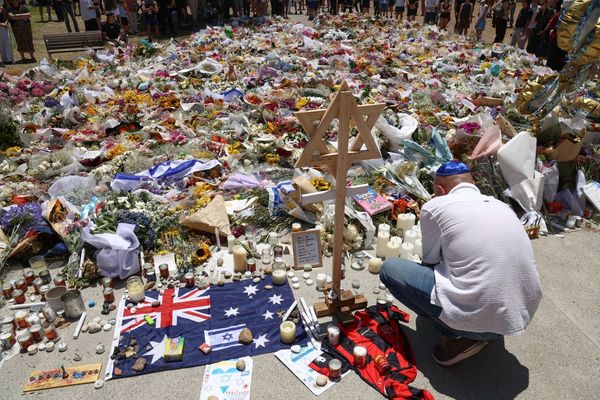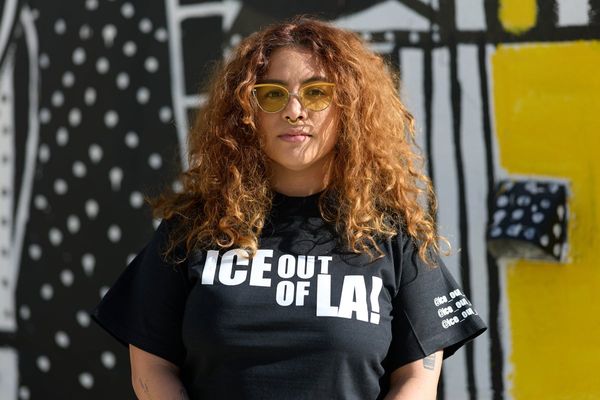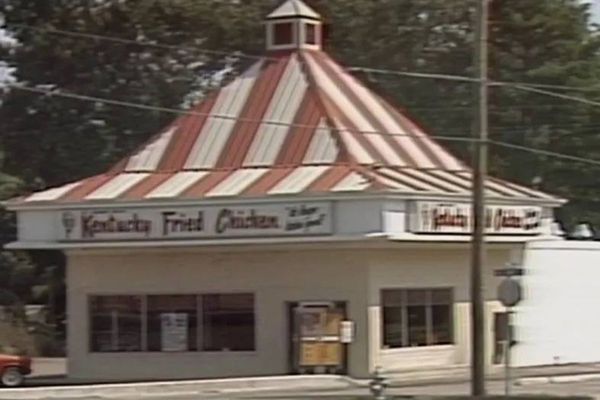
A piercing whistle sounds from the canopy of a stand of gum trees at the edge of rows of brick houses, newly built upon streets with names such as Pardalote Drive, Rufous Crescent and Thornbill Court.
“King parrot,” Hugh Possingham says – referring to the call, not a court or a crescent.
The mathematical ecologist is a professor at the University of Queensland and a leading figure in Australian conservation biology. The state’s chief scientist from 2020 to 2022, Possingham is also an avid birder and vice-president of BirdLife Australia.
On this day in late February he is joined by, Christina Zdenek, an ecologist and herpetologist with the Australian Reptile Academy, for a short hike through a couple of hundred hectares of eucalyptus woodland between Brisbane and Ipswich.
Their destination is a Eucalyptus fibrosa, or ironbark, possibly 100 years or older, that the two eminent scientists call “the poo tree”.
More bird calls are identified. That big warble is from a weebill, which – weighing only slightly more than a teaspoon of sugar – is Australia’s smallest bird. “Most of the birdwatching I do is actually bird listening,” Possingham says.
So what does the professor hear as he enters this stand of trees?
At its edges, where forest meets ever-encroaching housing, Possingham hears the brash and beautiful warbles of aggressive birds that dominate Brisbane’s suburbs: butcher birds, magpies, currawongs and the laser gun “pwee pwee pwee” of the noisy minor.
But as he enters the sanctuary of the forest, he says, the calls change. In the Woogaroo, Possingham might hear a harmony – or a cacophony – of more than 10 species of honeyeaters. Those birdsongs could be the rich melodies of golden and rufous whistlers (birds described by enthusiasts as virtuoso songbirds) or the delicate chirp of the varied sittella.
They are bird calls Possingham says are now increasingly rare in south-east Queensland; calls he fears could soon become rarer still.
The master planner
A lot has changed in the past 28 years – but the area known under the Ipswich city planning scheme as Lot 9999 has not.
On 23 January 1997, the internet was a novelty households accessed via the crunchy sounds of a dial-up modem and telephones were attached to landlines with cords. Koalas weren’t endangered and the land around Lot 9999, between Queensland’s capital Brisbane and the old coal mining city of Ipswich, was thickly wooded.
On that day in 1997, the Springfield development control plan was gazetted, setting in motion the transformation of 2,860 hectares (7,064 acres) of forestry land into the Ipswich suburbs encompassed by Greater Springfield. Reputedly the first privately built city in Australia, it aims to house a population as large as Darwin’s by the end of the decade.
The man behind Greater Springfield was Maha Sinnathamby, a property developer, and it would elevate him to billionaire “founder and visionary” status. With his business partner, Bob Sharpless, he would enter the Queensland business leaders’ hall of fame.
Almost three decades later, only about 420ha of the land on which Sinnathamby built his city remains “unrefined”. And at its heart is the nearly 160ha of Lot 9999.
But a coalition of scientists and residents want to block plans to sculpt and flatten this land to make way for about 1,800 houses. These campaigners gave Lot 9999 and the bush that remains around it a new name, one derived from a creek that runs through it: Woogaroo Forest.
Web of life
The Woogaroo is privately owned – not that you would know, standing at its edges, listening out for birds.
Joggers pound the tracks bulldozed through the trees that form deep scars or erosion through the forest. A popular outdoors website ranks it among the best near Ipswich, describing it as “a popular trail for hiking, mountain biking and running” though one in which visitors “can still enjoy some solitude during quieter times of day”.
Occasionally, 4WDs or dirt bikes whiz through. Near one entrance, mounds of rubbish have been dumped – and someone has cut down several large, old trees.
Zdenek talks about the “excellent” birds she sees in the Woogaroo too, including cicadabirds and mistletoe birds.
Her herpetologist’s eye, though, is trained to spot reptiles such as legless and frill-necked lizards. Woogaroo, she says, is home to one of south-east Queensland’s last populations of the famous frill-neck.
But an ecologist sees a forest in networks. So as well as her pet interests, Zdenek talks about the brush-tailed phascogale, a small, predatory arboreal hunter that calls Woogaroo home, along with marsupial gliders, powerful owls, tusked frogs and grey-headed flying foxes.
The two scientists speak admiringly of plants, too; of pockets of dense vine scrub, a habitat type of which only 2.4% remains in the Ipswich area, where it is classified as endangered.
And, of course, there are the trees.
They say the centuries-old ironbarks still dot Woogaroo, trees with wood too hard to cut or trunks too knobbly or misshapen to fashion into planks.
Finally, they talk of the “poo tree”. Last year, Zdenek spent six months with a UQ research lab to “conduct novel gut microbiome analyses” of koalas to help “deliver cost-effective wildlife monitoring services”.
“My job was to collect koala poo,” she says, holding a blob of scat she has collected from the base of that tree inside the Woogaroo. “If it is koala poo, and it is fresh, you just smell eucalyptus. If it’s possum poo, it just smells like shit.”
Zdenek crushes it and holds the scat to her nose; several months old now, it has lost its scent. But there are other giveaways. Possum poo has seeds in it, she says. Koala poo, on the other hand, is made up of only digested leaves – it is plumper, and has a greenish tinge.
“This is definitely koala poo.”
No preservation status
In May, an Ipswich city council assessment officer approved an application to reconfigure an area of Lot 9999 into as many as 982 residential lots, which developers have named Springview Village 3.
The land is marked as core koala habitat under the Queensland government’s koala habitat mapping and recent surveys and footage have shown koalas in the Woogaroo Forest. But development in Lot 9999 won’t need state approval because it has been exempted from koala habitat protection codes under the Springfield development control plan of 1997.
The mayor of Ipswich, Teresa Harding, has said she has and will continue to meet members of the Save the Woogaroo Forest group and that she understands their concerns. However, she says “unfortunately”, the Woogaroo is “not a preserved forest”.
“It is instead a privately owned parcel of land designated for residential development by the Queensland government close to 30 years ago,” the mayor says.
The landholder, Cherish Enterprises, referred questions to developer Stockland, which has signed a multimillion dollar deal for pre-emptive rights to buy and develop land in the Woogaroo. A Stockland spokesperson says the land is privately owned and zoned for residential use.
“The region’s need for more homes was well documented,” the spokesperson says.
“Stockland has a long and proud history helping more Australians achieve the dream of home ownership and we are committed to continue working with government and the community to provide housing options to first home buyers and families in south-east Queensland.”
The development of Lot 9999 will eventually have to pass across the desk of the federal environment minister because of its effect on threatened species, as will three other proposed developments in the Woogaroo.
All four referrals under the Environment Protection and Biodiversity Conservation Act languished for several years as the department waits for the developers to lodge more documents.
It is here that campaigners are staking their hopes for the forest’s future.
Prior to the federal election, the office of the federal environment minister, Tanya Plibersek, referred questions about Woogaroo to the environment department. A department spokesperson says “any future decision whether or not to approve developments in the area referred to as Woogaroo Forest, under national environmental law, will consider the impacts of those developments on matters of national environmental significance and will take into account the context of the proposed developments”.
Do the maths
As Possingham reflects on the need to house south-east Queensland’s booming population, he turns to the language of maths.
Over the next 20 years, he says, 2 million people will move to the region. By his calculations, half of them will move into areas of urban infill; the other half, to urban sprawl. Possingham calculates 30,000ha of greenfield land would be needed to build the houses for those 1 million people.
“There is plenty of completely degraded land with no biodiversity values at all to put those houses on,” he says. “There’s degraded agricultural land, there’s abandoned land, there’s abandoned mines … south-east Queensland is 6m hectares.
“If you can’t find 30,000ha in 6m hectares, then you are not looking very hard.”







